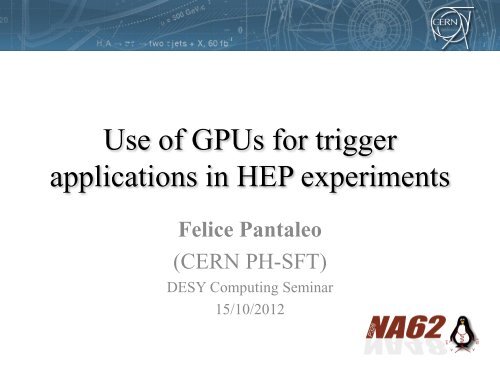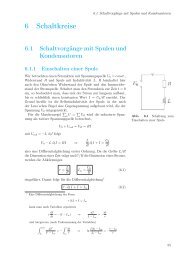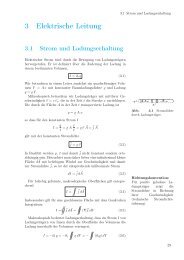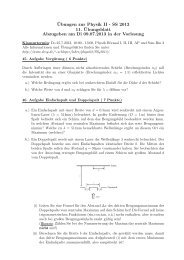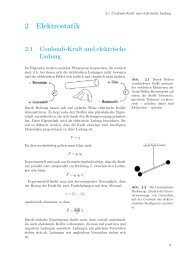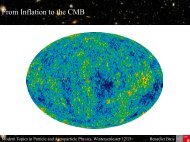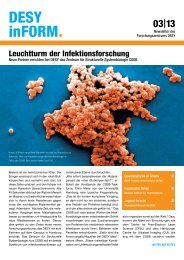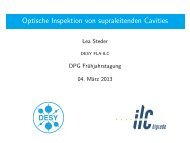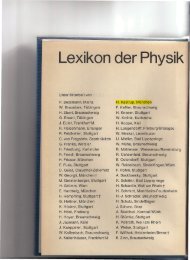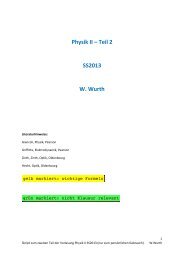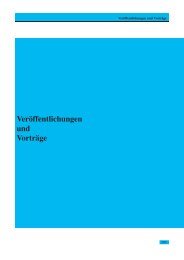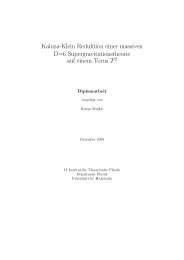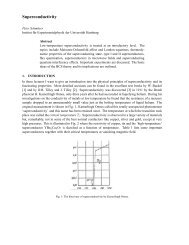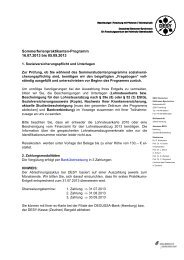Felice Pantaleo - Desy
Felice Pantaleo - Desy
Felice Pantaleo - Desy
Create successful ePaper yourself
Turn your PDF publications into a flip-book with our unique Google optimized e-Paper software.
Use of GPUs for trigger<br />
applications in HEP experiments<br />
<strong>Felice</strong> <strong>Pantaleo</strong><br />
(CERN PH-SFT)<br />
DESY Computing Seminar<br />
15/10/2012
Outline<br />
• Introduction<br />
• Graphic Processing Units<br />
• ALICE HLT<br />
• NA62<br />
– RICH<br />
– CHOD<br />
– Tests<br />
• Conclusion<br />
• Reference<br />
15/10/2012 felice.pantaleo@cern.ch<br />
2
Introduction
Introduction<br />
• High Energy Physics detectors needs<br />
– Processing large amounts of information<br />
– Very short time response<br />
– Complex structures, many sensors with<br />
topographic information<br />
– Efficient processing of data<br />
• Huge benefits expected from the use of<br />
Multicore techniques<br />
• Where are we ?<br />
15/10/2012 felice.pantaleo@cern.ch<br />
4
Generic Detector Structure<br />
15/10/2012 felice.pantaleo@cern.ch<br />
5
Generic Trigger Structure<br />
40 MHz<br />
Clock driven<br />
Custom processors<br />
100 kHz<br />
Event driven<br />
PC network<br />
Low Level Trigger<br />
NA62<br />
High-Level Trigger<br />
ALICE<br />
15/10/2012 felice.pantaleo@cern.ch<br />
6
Low Level Trigger<br />
• Time needed for decision Dt dec≈ 1 ms<br />
• Particle rate ≈ 10MHz<br />
• Need pipelines to hold data<br />
• Need fast response<br />
• Backgrounds are huge<br />
• High rejection factor<br />
• Algorithms run on local, coarse data<br />
• Ultimately, determines the physics<br />
15/10/2012 felice.pantaleo@cern.ch<br />
7
Parallel Opportunities<br />
• On detector (mostly Cellular Automata)<br />
– Trackers<br />
– Calorimeters<br />
• Trigger Systems<br />
– Event decision: one event per node + dispatcher<br />
• The Grid<br />
15/10/2012 felice.pantaleo@cern.ch<br />
8
Current Proposals: steps beyond<br />
Many GPU applications:<br />
• Reconstruction of tomographies in the European<br />
Synchrotron Radiation Facility<br />
• Integration of GPUs into the ITMS framework of<br />
data acquisition in fusion experiments<br />
• Track reconstruction simulation for PANDA in<br />
FAIR<br />
• NA62 Low-Level Trigger<br />
• ALICE High-Level Trigger<br />
15/10/2012 felice.pantaleo@cern.ch<br />
9
HEP is a long lived science...<br />
• Many algorithms in HEP have cores dating the<br />
seventies<br />
• Mostly thought and devised as single threaded<br />
• Current solution: one event-one core<br />
• This solution shows saturation<br />
Change of paradigm ?<br />
15/10/2012 felice.pantaleo@cern.ch<br />
10
Opportunities for HEP experiments<br />
• HEP characteristics and needs seem to fit<br />
perfectly both<br />
– Cellular techniques<br />
– Multi- Many- cores architectures<br />
• Our feeling: a large number of opportunities<br />
ahead of us<br />
• Further study is needed to evaluate the real<br />
benefits of these solutions.<br />
15/10/2012 felice.pantaleo@cern.ch<br />
11
Graphic Processing Units
GPUs (1/2)<br />
• Exceptional raw power<br />
wrt CPUs<br />
• Higher energy efficiency<br />
(NVIDIA Kepler PUE<br />
1.05)<br />
• Plug & Accelerate<br />
• Massively parallel<br />
architecture<br />
• Low Memory/core<br />
15/10/2012 felice.pantaleo@cern.ch<br />
13
GPUs (2/2)<br />
GPUs were traditionally used for real-time rendering.<br />
NVIDIA & AMD main<br />
manufacturers.<br />
Architecture (Kepler)<br />
• 7.1B Transistors<br />
• 15 SMX units<br />
• > 1 TFLOP FP64<br />
• 1.5 MB L2 Cache<br />
• 384-bit GDDR5<br />
• PCI Express Gen3<br />
15/10/2012 felice.pantaleo@cern.ch<br />
14
CUDA – Kepler Architecture<br />
• SMX executes hundreds of threads concurrently.<br />
• SIMT (Single-Instruction, Multiple-Thread)<br />
• Instructions pipelined<br />
• Thread-level parallelism<br />
• Instructions issued in order<br />
• No Branch prediction<br />
• No speculative execution<br />
• Branch predication<br />
15/10/2012 felice.pantaleo@cern.ch<br />
15
CUDA – Abstractions<br />
1. Hierarchy of thread groups<br />
2. Shared memory<br />
3. Barrier synchronization<br />
Fine-grained data/thread parallelism<br />
Coarse-grained data/task parallelism<br />
Instruction-level parallelism<br />
15/10/2012 felice.pantaleo@cern.ch<br />
16
ALICE High Level Trigger<br />
Thanks to D. Rohr (ALICE Collaboration)
What it is happening in HPC<br />
Use several platforms containing<br />
GPUs to solve one single problem<br />
Programming challenges:<br />
• Algorithm parallelization<br />
• Perform computation in GPUs<br />
• Execution in a distributed<br />
system where platforms have<br />
their own memory<br />
• Network communication.<br />
15/10/2012 felice.pantaleo@cern.ch<br />
18
ALICE Detector<br />
ALICE is one of the major four experiments of the Large<br />
Hadron Collider at CERN. It was specifically designed to<br />
study heavy ion collisions.<br />
15/10/2012 felice.pantaleo@cern.ch<br />
19
ALICE TPC<br />
A Time Projection Chamber (TPC) is used to<br />
measure particle trajectories.<br />
15/10/2012 felice.pantaleo@cern.ch<br />
20
ALICE TPC<br />
• TPC clusters of a heavy ion event<br />
15/10/2012 felice.pantaleo@cern.ch<br />
21
ALICE TPC<br />
• Tracks reconstructed from the clusters<br />
15/10/2012 felice.pantaleo@cern.ch<br />
22
ALICE HLT<br />
• Alice HLT tracker divides the TPC in slices<br />
and processes the slices individually.<br />
• Track segments from all the<br />
slices are merged later<br />
15/10/2012 felice.pantaleo@cern.ch<br />
23
Tracking algorithm<br />
Category of task Name of task Description on task<br />
Combinatorial part<br />
(Cellular automation)<br />
Kalman filter part<br />
(Initialization)<br />
I: Neighbors finding<br />
II: Evolution<br />
III: Tracklet<br />
construction<br />
Construct seeds<br />
(Track candidates)<br />
Fit seed,<br />
extrapolate tracklet,<br />
find new clusters<br />
IV: Tracklet selection Select good tracklets,<br />
assign clusters to<br />
tracks<br />
(Tracklet output)<br />
15/10/2012 felice.pantaleo@cern.ch<br />
24
Neighbors Finding<br />
15/10/2012 felice.pantaleo@cern.ch<br />
25
Evolution step<br />
15/10/2012 felice.pantaleo@cern.ch<br />
26
Tracklet reconstruction<br />
• The algorithm looks for clusters close to<br />
extrapolation point<br />
15/10/2012 felice.pantaleo@cern.ch<br />
27
Evolution step<br />
15/10/2012 felice.pantaleo@cern.ch<br />
28
Tracklet construction<br />
15/10/2012 felice.pantaleo@cern.ch<br />
29
Tracklet selection<br />
15/10/2012 felice.pantaleo@cern.ch<br />
30
ALICE GPU Tracker<br />
Screenshot of ALICE Online-Event-Display<br />
during first physics-fill with active GPU Tracker.<br />
15/10/2012 felice.pantaleo@cern.ch<br />
31
NA62
K + → π + νν in the Standard Model<br />
• FCNC process forbidden at tree<br />
level<br />
• Short distance contribution<br />
dominated by Z penguins and box<br />
diagrams<br />
• Negligible contribution from u<br />
quark, small contribution from c<br />
quark<br />
• Very small BR due to the CKM<br />
top coupling → λ 5<br />
ρ<br />
K 0 →π 0 νν<br />
α<br />
γ β<br />
K L→μ + μ -<br />
charm<br />
η<br />
• Amplitude well predicted in SM (measurement of<br />
V td) [see E.Stamou]<br />
• Residual error in the BR due to parametric<br />
uncertainties (mainly due to charm contributions):<br />
~7%<br />
• Alternative way to measure the Unitarity Triangle<br />
with smaller theoretical uncertainty<br />
G SD/G Irr. theory err. BR x 10 -11<br />
K L→πνν >99% 1% 3<br />
K + →π +νν 88% 3% 8<br />
KL→π0e + e- 38% 15% 3.5<br />
K L→π 0μ + μ - 28% 30% 1.5<br />
15/10/2012 33
Experimental Technique<br />
• Kaon decay in-flight from an unseparated 75 GeV/c hadron beam, produced with 400<br />
GeV/c protons from SPS on a fixed berilium target<br />
• ~800 MHz hadron beam with ~6% kaons<br />
• The pion decay products in the beam remain in the beam pipe<br />
• Goal: measurement of O(100) events in two years of data taking with % level of<br />
systematics<br />
• Present result (E787+E949): 7 events, total error of ~65%.<br />
15/10/2012 felice.pantaleo@cern.ch<br />
34
NA62 Trigger<br />
RICH MUV CEDAR STRAWS LKR LAV<br />
1 MHz<br />
L1/L2<br />
PC<br />
10 MHz<br />
L0 trigger<br />
L1 trigger<br />
Trigger primitives<br />
Data<br />
L1/L2<br />
PC<br />
L1/L2<br />
PC<br />
L0TP L0<br />
GigaEth SWITCH<br />
L1/L2<br />
PC<br />
CDR<br />
L1/L2<br />
PC<br />
O(KHz)<br />
L1/L2<br />
PC<br />
1 MHz<br />
100 kHz<br />
L1/L2<br />
PC<br />
10 MHz<br />
L1/2<br />
EB<br />
L0: Hardware<br />
synchronous level.<br />
10 MHz to 1 MHz.<br />
Max latency 1 ms.<br />
L1: Software level.<br />
“Single detector”. 1<br />
MHz to 100 kHz<br />
L2: Software level.<br />
“Complete<br />
information level”.<br />
100 kHz to few<br />
kHz.<br />
15/10/2012 felice.pantaleo@cern.ch<br />
35
GPU as a Level 0 Trigger<br />
• The idea: exploit GPUs to<br />
perform high quality analysis at<br />
trigger level<br />
• GPU architecture: massive<br />
parallel processor SIMD<br />
• "Easy" at L1/2, challenging at<br />
L0<br />
• Real benefits: increase the<br />
physics potential of the<br />
experiment at very low cost!<br />
• Profit from continuative<br />
developments in technology for<br />
free (Video Games,…)<br />
TESLA<br />
GPU<br />
INTEL PRO/1000<br />
QUAD GBE<br />
100GB/s<br />
(500 MHz)*<br />
PCI-Ex<br />
x16<br />
4 GB/s<br />
(20 MHz)*<br />
15/10/2012 felice.pantaleo@cern.ch<br />
36<br />
V<br />
R<br />
A<br />
M<br />
“quasi-triggerless” with GPUs<br />
FE<br />
R<br />
A<br />
M<br />
30 GB/s<br />
(150 MHz)*<br />
CPU<br />
CPU<br />
Digitization + buffer +<br />
(trigger primitives) PCs+GPU<br />
L0<br />
PCs+GPU<br />
L1
Data Flow<br />
Max time O(100us)<br />
Receive data<br />
Filling appropriate<br />
data structures<br />
Transfer the whole structure to<br />
GPU Memory<br />
Kernel<br />
Transfer the results to<br />
the Host and back to<br />
sub-detectors<br />
Using a "zero copy" intel<br />
modded driver, we are able to<br />
copy data from the NIC<br />
directly to the userland<br />
exploiting<br />
concurrency<br />
15/10/2012 felice.pantaleo@cern.ch<br />
37
NA62 RICH Level0 Trigger
RICH<br />
• ~17 m RICH<br />
• 1 atm Neon<br />
• Light focused by two mirrors on two spots equipped with ~1000 PMs each (pixel 18 mm)<br />
• 3s p-m separation in 15-35 GeV/c, ~18 hits per ring in average<br />
• ~100 ps time resolution, ~10 MHz events rate<br />
• Time reference for trigger<br />
15/10/2012 felice.pantaleo@cern.ch<br />
39
Ring Reconstruction<br />
• Natively built for<br />
pattern recognition<br />
problems<br />
• First attempt: ring<br />
reconstruction in<br />
RICH detector.<br />
It's a pilot project, very<br />
promising R&D!<br />
GPU 12 hits<br />
Best ring<br />
Hits generated<br />
NA62 - G4 MC<br />
15/10/2012 felice.pantaleo@cern.ch<br />
40
Crawford Algorithm<br />
Consider a circle of radius R, centered in (x 0, y 0)and a list of points (x i, y i).<br />
The following relations exist:<br />
15/10/2012 felice.pantaleo@cern.ch<br />
41
Reduction<br />
• One reduction kernel is called per block, giving an array of results (one for each event)<br />
• Must use sequential addressing instead of interleaved addressing to avoid Shared Memory bank conflicts<br />
• Time complexity is O(logN), cost is O(N*logN): not cost efficient<br />
• Brent's theorem (algorithm cascading) suggests O(N/logN) threads:<br />
o Each thread does O(logN) sequential work<br />
o All O(N/logN) threads cooperate for O(logN) steps<br />
o New cost = O(N/logN * logN) = O(N)<br />
15/10/2012 felice.pantaleo@cern.ch<br />
42
GPU grid organization<br />
threadIdx.y = ring[j]<br />
threadIdx.x = hit[i]<br />
Stream[k]<br />
15/10/2012 felice.pantaleo@cern.ch<br />
43
Stream Scheduler<br />
• Exploit the instruction-level<br />
parallelism (i.e. pipelining<br />
streams)<br />
• This is usually done by<br />
interlacing one stream<br />
instructions with another<br />
stream ones<br />
• This cannot be done in realtime<br />
without the introduction<br />
of other unknown latencies<br />
• CPU thread-level parallelism<br />
is the solution<br />
15/10/2012 felice.pantaleo@cern.ch<br />
44
NA62 RICH Tests
Hardware configuration (1/2)<br />
First Machine<br />
• GPU: NVIDIA Tesla C2050<br />
o 448 CUDA cores @ 1.15GHz<br />
o 3GB GDDR5 ECC @ 1.5GHz<br />
o CUDA CC 2.0 (Fermi Architecture)<br />
o PCIe 2.0 (effective bandwidth up to ~5GB/s)<br />
o CUDA Runtime v4.2, driver v295.20 (Feb '12)<br />
• CPU: Intel® Xeon® Processor E5630 (released in Q1'10)<br />
o 2 CPUs, 8 physical cores (16 HW-threads)<br />
• SLC6, GNU C compiler v4.6.2<br />
46
Hardware configuration (2/2)<br />
Second Machine<br />
• GPU: NVIDIA GTX680<br />
o 1536 CUDA cores @ 1.01GHz<br />
o 2GB GDDR5 ECC @ 1.5GHz<br />
o CUDA CC 3.0 (Kepler Architecture)<br />
o PCIe 3.0 (effective bandwidth up to ~11GB/s)<br />
o CUDA Runtime v4.2, driver v295.20 (Feb '12)<br />
• CPU: Intel® Ivy Bridge Processor i7-3770 (released in<br />
Q2 '12)<br />
o 1 CPUs, 4 physical cores (8 hw-threads) @3.4GHz<br />
• Fedora 17, GNU C compiler v4.6.2<br />
47
Results - Throughput<br />
The throughput behaviour for a varying<br />
number of events inside a packet is a typical<br />
many-core device behaviour:<br />
• constant time to process a varying<br />
number of events, activating more SMs<br />
as the packet size increases<br />
• discrete oscillations due to the discrete<br />
nature of the GPU<br />
• saturation plateau (1.4GB/s and<br />
2.7GB/s )<br />
The right choice of packet dimension is not<br />
unique.<br />
It depends on the maximum latency we<br />
don't want to exceed and on the input rate of<br />
events.<br />
Considering that the maximum rate per subdetector<br />
(@10MHz particles rate) for NA62<br />
experiment is ~500MB/s, I would consider<br />
the throughput test PASSED<br />
felice.pantaleo@cern.ch<br />
48
Results - Latency<br />
Latency pretty stable wrt event<br />
size.<br />
• A lower number of event<br />
inside a package is better to<br />
achieve a low latency.<br />
• A larger number of event<br />
guarantees a better<br />
performance and a lower<br />
overhead.<br />
The choice of the packet size<br />
depends on the technical<br />
requirements.<br />
15/10/2012 felice.pantaleo@cern.ch<br />
49
Results - Latency Stability<br />
15/10/2012 felice.pantaleo@cern.ch<br />
50
NA62 CHOD Level0 Trigger
CHOD<br />
Opportunity to run test on a running subdetector.<br />
Aim: Applying time corrections in real-time<br />
can improve time resolution.<br />
Divide et Impera:<br />
• Real-Time-Ready data structures receiver<br />
implemented.<br />
• Fast communication between Network<br />
Interface buffers and Host Memory<br />
(DNA driver) implemented<br />
• A throughput/latency efficient kernel<br />
implemented<br />
Integrate the single unit tests<br />
Due to the slabs<br />
length, all the<br />
times measured<br />
by PMTs need to<br />
be corrected.<br />
15/10/2012 felice.pantaleo@cern.ch<br />
52
CHOD – Kernel<br />
• Assuming the conditions of the<br />
detector to be stable, the kernel<br />
is an increment by a value<br />
taken from a lookup table.<br />
• Each element of the lookup<br />
table contains the correction<br />
specific of each rectangular<br />
zone.<br />
• Each zone correction is the<br />
central point one.<br />
15/10/2012 felice.pantaleo@cern.ch<br />
53
CUDA Kepler Architecture<br />
Investigation on which memory to use to<br />
store this matrix:<br />
Global memory (read and write)<br />
• Slow, but now with cache<br />
• L1 cache designed for spatial re-usage,<br />
not temporal (similar to coalescing)<br />
• It benefits if compiler detects that all<br />
threads load same value (LDU PTX<br />
ASM instruction, load uniform)<br />
Texture memory<br />
• Cache optimized for 2D spatial access<br />
pattern<br />
Constant memory<br />
• Slow, but with cache (8 kb)<br />
Shared memory (48kB per SMX)<br />
• Fast, but slightly different rules for<br />
bank conflicts now<br />
Registers (65536 32-bit registers per<br />
SMX)<br />
15/10/2012 54
NA62 CHOD Tests
Kernel 8x8<br />
15/10/2012 56
Kernel 64x64<br />
Texture memory is slower but way more<br />
latency-stable than the others<br />
15/10/2012 57
Time dependency<br />
Latency stable in time<br />
Secondary peaks due only to caches<br />
hit/miss and not time correlated<br />
15/10/2012 58
Throughput<br />
Saturation at ~3GB/s<br />
(I/O bound)<br />
15/10/2012 59
Latency<br />
30<br />
25<br />
20<br />
15<br />
0 2000 4000 6000 8000<br />
15/10/2012 60
Conclusion<br />
• I will test a complete system in the first NA62<br />
technical run in November.<br />
• GPUs seem to represent a good opportunity, not<br />
only for analysis and simulation applications, but<br />
also for more “hardware” jobs.<br />
• Replacing custom electronics with fully<br />
programmable processors to provide the<br />
maximum possible flexibility is a reality not so<br />
far in the future.<br />
15/10/2012 felice.pantaleo@cern.ch<br />
61
Conclusion<br />
• GPU now mature to be used in HEP in<br />
particular in dedicated triggers.<br />
• Already in use in HLT in ALICE for TPC<br />
reconstruction<br />
• First test as Level0 trigger processor in NA62<br />
next month<br />
15/10/2012 felice.pantaleo@cern.ch<br />
62
Questions?
Reference<br />
Real-Time Use of GPUs in NA62 Experiment<br />
F. <strong>Pantaleo</strong> et al., 13th International Workshop on Cellular<br />
Nanoscale Networks and their Applications (CERN-PH-EP-2012-<br />
260)<br />
ALICE HLT TPC Tracking on GPUs<br />
D. Rohr et al., CNNA2012<br />
Many-core processors and GPU opportunities in Particle<br />
Detectors<br />
X. Vilasís Cardona et al. CNNA2012<br />
15/10/2012 felice.pantaleo@cern.ch<br />
64


